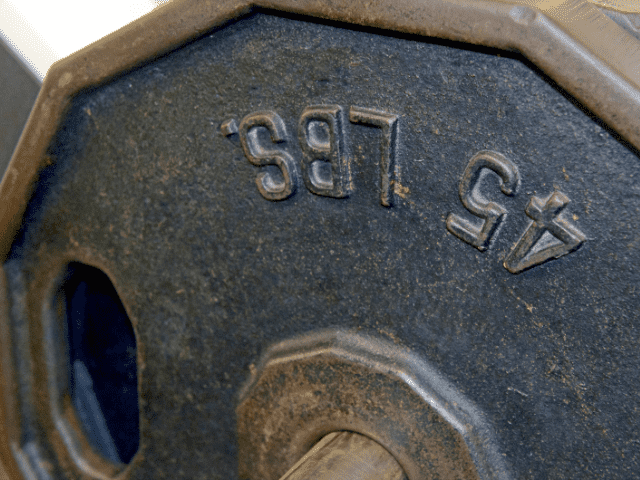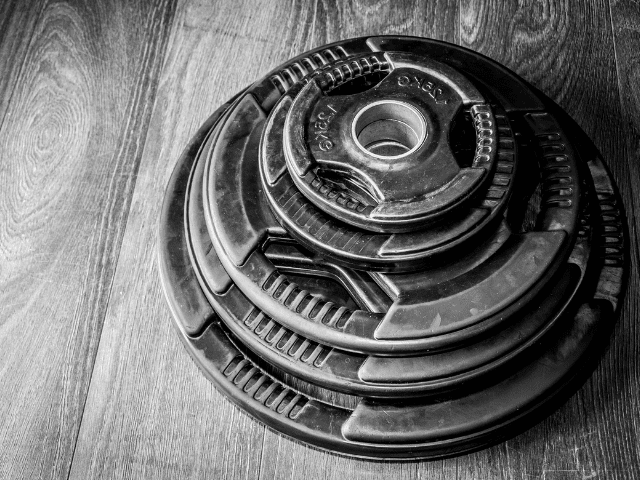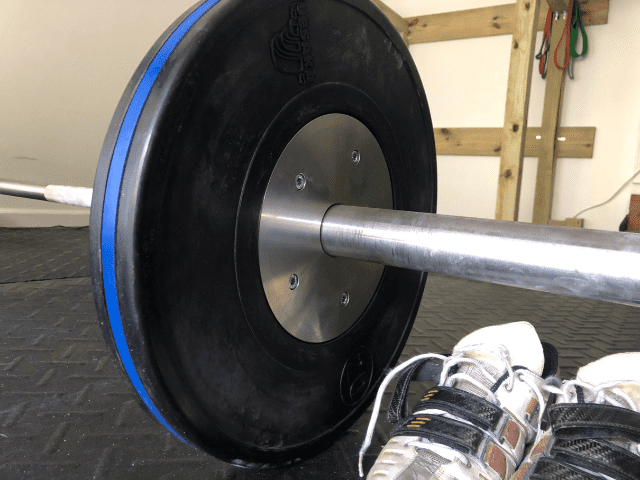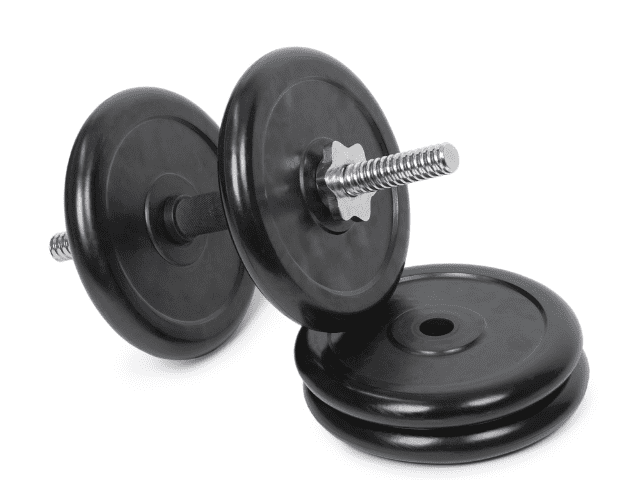How Many Weight Plates Do You Need (Home Gym 101)
Building out a home gym properly takes a good amount of planning. Gym equipment, including a barbell and weight plates, is expensive and you can blow through a home gym budget incredibly fast.
A key to making your budget stretch as much as possible is to know what equipment you need and, just as importantly, what equipment you don’t.
When it comes to weight plates, how many weight plates do you need for a home gym?
All home gyms should have two 45-pound plates, two 25s, two 10s, two 5s and two 2.5s. This provides every weight combination from just the bar up to 220 pounds. An experienced lifter should then add 45s to their set as necessary.
Chances are though, you still have more questions like –
Do you need 35-pound plates? What kind of plates do you need for your home gym? How much weight generally comes in a set and are those even worth buying?
Don’t worry, I’ve got you covered. I’ll let you know why the combination of plates I described above is the perfect amount and how to know what types of weight plates you need (and don’t need) for your home gym.
How Many Weight Plates You Actually Need

At the top of this article I stated that the proper amount of weights you need for your home gym are:
- 2 – 45 pound plates
- 2 – 25 pound plates
- 2 – 10 pound plates
- 2 – 5 pound plates
- 2 – 2.5 pound plates
Then, add 45-pound plates to your gym as necessary depending on your strength.
But, why is this the correct amount of weight plates?
You want to have the right combo of plates to be able to put the correct amount of weight on the bar that you need, whatever that weight may be. And that is exactly what this combination gives you.
Let’s use the example of someone who begins to bench press with just the bar and continues to add weight to the bar each workout as they continue to get stronger.
During their second workout (after using just the bar) they could go from lifting a total weight of 45 to 50 pounds by simply adding 2.5s to the bar. Then a total of 55 by taking off the 2.5s and replacing them with 5s. Put the 2.5s back on top of the 5s and now they’re at 60 pounds.
You can keep adding weight to the bar and switching to bigger plates as necessary like this from 45 pounds (what the barbell itself weighs) all the way up to 220 pounds.
225 pounds requires two 45-pound plates on each side of the bar. So, if you need more weight than 220 pounds then you will need a total of four 45-pound plates.
How many weight plates you’ll ultimately end up with for your home gym will be based on how many 45-pound plates you need.
Once you get to 315 pounds, you’ll need an extra pair of 45s. Then another pair for 405, 495 and if you ever get strong enough to lift 6 45s on each side of the bar you’ll be moving 585 pounds. Congrats.
How many plates this ends up being will depend on the heaviest weight you use for any one particular exercise. This is almost always one of the core compound lifts like deadlift, squat or bench press. If you know how much you can deadlift, then you know how many plates you need.
What About 35 Pound Plates?
While shopping for weight plates, you may have noticed many companies selling 35-pound plates. Most commercial gyms also carry 35-pound plates as well, but do you need them?
In my opinion, 35-pound plates are a complete waste of money and space in your home gym.
You can achieve the same weight on the bar efficiently by adding a 25 and a 10.
Even a 15kg (33lbs) bumper plate that is being used for Olympic lifts is not really necessary. A 10kg plate and change plates (the smaller plates) will still do the job just fine.
How Much Weight is in a Weight Plate Set?

If you decide to buy a set of weight plates instead of piecing them all together one by one, you can usually take advantage of a bit of a discount, however you have to really pay attention to exactly what you’re buying.
Some weight plate sets also include a barbell as well. When I think of the full barbell and plate set I immediately think of ‘complete sets’ you can find at almost every big box retailer including Wal-Mart and online at Amazon.
There are a couple of reasons you should, in my humble opinion, probably steer clear of these ‘complete sets’.
First, most (but not all to be fair) are mediocre equipment at best. If you’re buying a boxed all-in-one set at a retail store, it’s probably not the best and you may find yourself buying everything a second time a couple of years from now.
(On the other hand, quality equipment can last a long, long time)
Second, if you already have an Olympic bar then you don’t need a set of weight plates that comes with another one. (Unless you want a second bar, in that case, bully for you)
The other downside with many of these sets is they will include a set of 35-pound plates, which as we’ve already discussed you don’t really need.
So, what you have to decide is – is the discount you’re getting by buying a set worth taking the plates you don’t really need (and money that could then go to another set of 45s)
Finally, you would assume all sets would come with 2 weight plates for each weight, but you would be wrong. I’ve personally seen ‘sets’ that come with 2 of some weights, but only 1 of others.
It makes zero sense and I don’t have the slightest idea why they do it and who would want a set like that, but be aware that they do exist and make sure you’re getting the correct weight plates that you want.
Cast Iron or Bumper Plates

Speaking of bumper plates, do you need bumper plates for your home gym or cast iron plates? Or both?
This depends solely on what type of lifting you’re going to be doing in your home gym.
If you’re going to be doing Olympic lifting – cleans, snatches, jerks, etc – then you absolutely need bumper plates.
Whether you’re focused solely on Olympic lifts or they are just a part of your training (Crossfit or Sports Performance for instance), dropping a barbell repeatedly on the ground with cast iron plates will eventually destroy the bar, the plates and your floor and not necessarily in that order.
Also, cast iron plates do not rotate, or spin, like bumper plates do. This makes doing power cleans a nightmare with bumper plates even if you promise yourself you “won’t drop the weights on the floor”. (You will by the way)
However, what if you have no plans of doing any Olympic lifts at all? You just need weight plates for bench press and other general strength training.
In that case, all you really need is a set of cast iron weight plates. Cast iron plates are still going to look great and are going to cost you a lot less money.
Olympic Plates vs Standard Weight Plates

Notice when I was mentioning bumper plates, that I was not referring to them as Olympic plates. That was intentional.
Barbells and weight plates have some rather frustrating (and confusing) naming quirks when it comes to using the word “Olympic”.
I’ll spare you some of the boring details, but basically, if you thought Olympic plates were plates made for Olympic lifting that would totally make sense, but that’s not really what it means at all.
The word “Olympic” when used with weight plates are plates that have a 2″ center hole diameter which is designed to fit an “Olympic barbell” that also has a 2″ diameter.
However, this term includes both bumper plates and cast iron plates – as long as they have a 2″ (1.97 to be exact) hole diameter.
So, what the heck are standard weight plates?
Standard weight plates are plates that have a 1″ center hole, made specifically to fit 1″ bars. These plates are becoming more and more uncommon and there’s a chance you’ve never even seen a set of these plates.
Because of this, I would also try to avoid buying plates of this type (you can sometimes find them pretty cheap on used marketplaces like Facebook).
Final Thoughts
How many weight plates do you need for your home gym?
The final answer is based heavily on how strong you are. The stronger you are the more weight you’re going to need.
When it comes to all the weights less than a 45 though, there is no need to have five sets of 10-pound plates laying around your home gym unless you just really enjoy some epic bicep curl drop sets.
My final piece of advice is to just start with how much weight you currently need. Then, when you reach the next milestone in your strength, 315, 405, etc – reward yourself with a brand new pair of weight plates.
This will make hitting that next goal just a little bit sweeter.
Stay strong!

